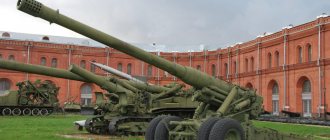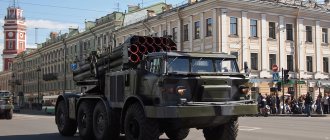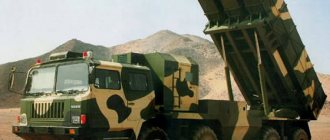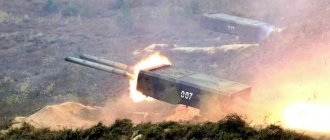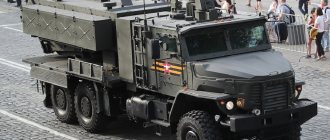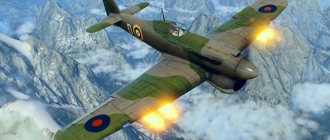Multiple launch rocket system 9K51M "Tornado-G"
The 9K51M Tornado-G multiple launch rocket system is designed to provide fire damage to open and covered manpower, unarmored and lightly armored vehicles, artillery and mortar batteries, command posts and other enemy targets when they are located in areas of concentration and during combat operations.
The Tornado-G MLRS can be classified as a new generation of the world-famous Grad multiple launch rocket system; unlike its predecessor, it has an increased firing range due to the use of new projectiles and an increased speed of bringing the system into combat readiness.
Development work on the creation of the Tornado-G MLRS was completed in 2013. By order of the Minister of Defense No. 760/DSP dated October 16, 2014, in pursuance of the order of the Government of the Russian Federation, the 122-mm 9K51M Tornado-G MLRS was put into service. The system is supplied and used by the troops (see.
,
). In 2022, to support the educational process, the Tornado-G MLRS was delivered to the Mikhailovsky Military Artillery Academy.
In April 2012 18 combat vehicles of this system entered service with the 20th Separate Guards Motorized Rifle Brigade (see review).
The Tornado-G MLRS is part of the artillery of motorized rifle (tank) brigades and artillery regiments of motorized rifle (tank) divisions.
One of the participants in the work on theoretical support for development in terms of efficiency, reliability and quality within the framework of R&D "Tornado-G" was Boris Andreevich Avotyn (JSC NPO SPLAV).
For the development of the Tornado-G multiple launch rocket system, the development group was awarded a Government Prize (2015). From PJSC Motovilikha Machine-Building named after B.L. Vannikova (JSC Mash), along with the production of warheads for the Grad MLRS, new types of warheads of increased power for the Tornado-G MLRS are being produced.
At the International Exhibition of Arms and Military Equipment Indo Defense - 2022, which was held in Jakarta (Indonesia) from November 7 to 10, 2022, specialists from NPO SPLAV JSC for the first time at a foreign exhibition exhibited a model of a 122-mm unguided rocket with high-explosive fragmentation warhead of increased power (index 9M538) for the Tornado-G MLRS.
In the future, rockets for the Tornado-G MLRS will be guided.
Finish off with one gulp: the troops received new missiles for the Tornado-G
Deliveries to the troops of the latest missiles for Tornado-G multiple launch rocket systems have begun. They not only enter a given area with extreme precision, but also hit the target with detachable warheads. The latter, using a stabilizing parachute, fall onto the target almost vertically, so it is difficult to defend against them. Such ammunition easily destroys armored vehicles, manpower and even field fortifications, experts noted. These missiles are two-stage, they can strike targets from different directions and at different angles.
Rocket on parachute
A high-precision missile of a new design has been created for the Tornado-G multiple rocket launchers. It has already been tested, put into service and supplied to the troops, sources in the military department told Izvestia.
New ammunition allows you to fire a salvo from one launcher at several targets at once or concentrate the fire of several multiple launch rocket systems on one. This is why a two-stage circuit is used instead of the traditional single-stage one. In addition, the missiles have a detachable warhead, which makes it impossible for them to be intercepted by modern air defense systems. The ammunition allows you to hit objects even in shelters and behind reverse slopes of heights - this is beyond the power of conventional Grads.
As Izvestia previously wrote, 300-mm rockets from Tornado-S heavy multiple launch rocket systems, which are now being replaced by the famous Smerch, have the same capability.
Knock out in one gulp: new rocket systems appeared in Kaliningrad
Artillerymen of the coastal forces of the Baltic Fleet received the Smerch MLRS division
Earlier, the Ministry of Defense announced the first use of new missiles for the Tornado-G with a detachable warhead as part of the Caucasus-2020 exercises. According to the military, such ammunition falls almost vertically onto the object using a stabilizing parachute. This ensures a high degree of destruction of targets behind cover. During one of the episodes of the exercise, which took place at the Prudboy training ground near Volgograd, rocket artillery destroyed the armored vehicles of the mock enemy. At this stage, more than 20 Tornado-G MLRS were used. As a result, over 15 armored vehicles were destroyed.
The advantage of MLRS over conventional artillery is its wave destruction, former Deputy Minister of Defense for Armaments, Colonel General Anatoly Sitnov, told Izvestia.
“During normal shelling, a person can run to cover and hide within 40 seconds. This is almost impossible under fire from a rocket launcher; it fires shell after shell at intervals of less than a second,” the expert explained. “In addition, when using MLRS, a seismic wave is created that destroys dugouts and other shelters.
The general emphasized that modern rocket systems and high-tech ammunition for them were able to appear because work on their development has been carried out continuously over the past decades. Even in the most financially difficult years, fundamental research and design development did not stop, and research institutes and design bureaus were able to maintain personnel potential.
"Prima" from the Union
During the Soviet Union and after its collapse, attempts were also made to replace the Grads. The creation of a successor to the famous system was initiated by the Council of Ministers of the USSR back in 1976. At the end of the 1980s, the Prima MLRS developed at NPO Splav was put into service and limited deliveries to the troops began. The installation had an increased number of guides compared to its predecessor: 50 versus 40. New 9M53F missiles with a detachable warhead, which was equipped with a small jet engine and a parachute, were also created for it. She could attack targets, also falling on them almost vertically - at an angle of 85-90 degrees. In combination with a remote fuse, which could be programmed to the desired detonation height, this increased their combat effectiveness.
Pocket Iskander: the military will receive high-precision missile systems
VTRC launchers can be placed on armored vehicles
The developers stated that to hit the same target, 5–19 times fewer Prima installations with new ammunition are required than conventional Grad MLRS. However, due to the financial situation in which the army was in the early 1990s, the installation did not go into large production and was withdrawn from the units that managed to receive it.
Advantages of Tornado
The replacement for the Grads came only in 2014, when the 9K51M Tornado-G system was adopted. The group of its creators was awarded a prize by the Russian government in 2015. The main difference between the new Tornado-G is the automated fire control and preparation system for launching projectiles. The satellite navigation subsystem included in its composition allows you to accurately track the coordinates of each combat vehicle and calculate all the necessary data for opening fire. Information about the enemy’s location can not be entered manually, but obtained from drones, technical reconnaissance equipment or from the automated control system of a higher headquarters. This is what makes it possible to radically improve the accuracy of the use of MLRS compared to the Grad and Prima. It is planned that by the end of this decade all MLRS units will be re-equipped from Grad combat vehicles to the latest Tornado-G.
One of the advantages of the system was the use of several types of ammunition at once. Among them, for example, is an extended-range unguided missile capable of hitting a target 40 km away. This is twice as much as ammunition for Grad. Its ammunition also includes a missile with a cluster warhead with fragmentation-cumulative submunitions. They are capable of penetrating armor up to 140 mm thick. This is more than the thickness of the armor of modern tanks in their upper part, where the new missiles attack.
MLRS
Tornado G 1
9K51M "Tornado-G" - a modernized multiple launch rocket system. Created on the basis of the 9K51 Grad MLRS. Developed at the Federal State Unitary Enterprise State Research and Production Enterprise "Splav". The system is two-caliber and combines “Grad” and “Smerch” on one platform. The installation can leave the position even before the projectile reaches the target. This is achieved through automation of shooting. The system is capable of striking both in a salvo and with single high-precision missiles.
The 122-mm Tornado-G MLRS should eventually replace the BM-21 Grad, which has been in service since 1963. The MLRS is designed to strike open and hidden enemy personnel, armored vehicles, artillery and mortar batteries, and command posts. In terms of combat effectiveness, the system is 2.5-3 times superior to the Grad due to the power of the ammunition, range, accuracy of combat, accuracy of the automated aiming system and satellite guidance.
The 9K51M multiple launch rocket system includes the modernized 2B17-1 combat vehicle, old and new types of 122-mm rockets, as well as the Kapustnik-BM KSAUO. The combat capabilities of the new system were expanded with new rocket-propelled ammunition. The range includes cluster shells with a detachable warhead and self-aiming cumulative combat elements, which make it possible to effectively hit enemy armored combat vehicles. The maximum range was increased to 40 km. To ensure firing of projectiles with a detachable warhead, the combat vehicles were equipped with setters for the trigger time of the rocket fuse.
The cockpit of the combat vehicle contains remote installation equipment and an automated fire control system developed at the Signal All-Russia Research Institute. ASUNO allows you to fire without topographic and geodetic preparation and to guide the package with guides without the crew leaving the cockpit. Information about the route and the position of the guide package is automatically displayed on a special video monitor. The crew of the vehicle was reduced from 3 to 2 people, the deployment time in an unprepared combat position was reduced to 6 minutes, and in a prepared combat position to 1 minute.
Tornado G 3
Characteristics:
- Chassis: Ural-4320;
- Weight in combat position, kg: 14,000;
- Length in stowed position, mm: 7350;
- Width in stowed position, mm: 2040;
- Height in stowed position, mm: 3000;
- Ground clearance, mm: 410;
- Caliber, mm: 122;
- Number of guides: 40;
- Maximum firing range, m: according to various sources, from 40,000 to 100,000;
- Maximum elevation angle, degrees: 55;
- BM calculation, people: 2;
- Transfer of the system from traveling to combat position no more than, min: 0.5;
- Volley time, s: 20;
- Engine type: KamAZ-740;
- Engine power, hp: 210;
- Maximum speed on the highway, km/h: 85;
- Wheel formula: 6×6.
Russia is developing the Tornado-G MLRS on a tracked platform
Representatives of the Russian military-industrial complex are working on a number of military innovations, noted the General Staff of the Russian Armed Forces. In particular, designers are preparing the Tornado-G multiple launch rocket system (MLRS) for the transition to the tracked chassis of two-link all-terrain vehicles of the Vityaz series.
The Pantsir-SA air defense system on the DT-30PM chassis. Photo: vitalykuzmin.net
“Tornado-G MLRS on DT” is one of the promising complexes that are being developed in Russia. This was stated in an interview with the Krasnaya Zvezda newspaper by the head of the planning department for providing the Armed Forces with main types of weapons, military equipment and other means of the Main Organizational and Mobilization Directorate of the General Staff of the RF Armed Forces, Major General Alexander Dudkin.
To protect the Arctic?
Tracked tractors developed by Mashinostroitelnaya JSC (part of the Uralvagon concern) were talked about again after the premiere of the “Arctic” air defense systems Tor-M2DT and Pantsir-SA. What distinguishes them from conventional analogues is the chassis - the two systems are based on the DT-30 two-link tracked transporter, which is characterized by high maneuverability and conditions for crew activity in low temperatures.
Probably, the Tornado-G MLRS will also be based on the DT-30PM platform - a version of the tractor with armor for the vehicle’s living compartment. Let us remind you that the vehicle is equipped with an 800-horsepower diesel engine, which drives two caterpillar tracks through a semi-automatic gearbox. Wide rubber-fabric tracks cause low specific ground pressure (0.3 kg/sq. cm). The DT-30 can swim, move through swamps, virgin snow, and overcome an incline of 30 degrees on dry ground. The temperature range at which the Vityaz can be operated is from -50 to +50 degrees. The load capacity of the tractor is 30 tons - with a similar weight of the vehicle itself. This is enough to install MLRS and transport ammunition and personnel.
Combat vehicle 2B17-1 from the Tornado-G MLRS. Photo: vitalykuzmin.net
The Tornado-G MLRS is a modernization of the 122 mm caliber Grad system. The Tornado on a wheeled chassis received 40 guides with an elevation angle of up to 55 degrees - the firing range reaches 40 km. The modernization differs from the Grad system in a set of automated fire control tools with satellite navigation, which made it possible to reduce the crew and the deployment time of the system.
Installing the MLRS on a specialized tracked chassis will allow the Tornado-G to be used in difficult Arctic conditions. Let us remind you that the 9K51M Tornado-G complex on a wheeled chassis has been in operation since 2012.
Found a typo? Select a fragment and press Ctrl+Enter.
Tags: Land equipment Arctic ZRPK "Pantsir" RZSO "Polonaise" Rostec Tornado Uralvagonzavod
Previous article In series. Mi-26T2V - heavy large-body military transport helicopter
Next article Detect a spy drone by sound. Acoustic reconnaissance module from Rostec
Provided by SendPulse
Likes 0
Tornado installation: The NATO brigade will be destroyed in a few minutes
Boris Belobragin, chief designer of NPO Splav, spoke about the secrets of the Tornado-G multiple launch rocket system (MLRS), which replaced the Grad, in an interview with the Zvezda TV channel .
In the Soviet and then in the Russian army, two MLRS of different calibers were widely used: “Grad” of 122 mm caliber and “Smerch” of 300 mm caliber. The Grad, which has a firing range of 42 km and has 40 guides on a wheeled chassis for launching rockets, entered the army in 1963. Due to its high efficiency, the salvo covers an area of 145 thousand square meters. meters, almost 90 countries of the world have acquired this system. And now, after half a century, the Grad MLRS is in service in more than sixty countries around the world. Which was predetermined by its efficiency and reliability.
The Smerch MLRS is much younger; it was put into service in 1987. It has 12 guides, the shells cover an area of 670 thousand square meters. meters. The maximum firing range is 100 km. The effectiveness of this system is such that a salvo of six combat vehicles is capable of stopping the advance of a motorized rifle division.


